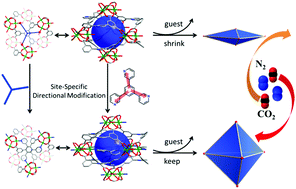Remoulding a MOF’s pores by auxiliary ligand introduction for stability improvement and highly selective CO2-capture†
Abstract
A new highly porous mixed-valence metal–organic framework, Co-pydc, was synthesized and characterized. Upon guest loss, Co-pydc irreversibly transformed to a closed structure and lost pore functionality. Then an auxiliary ligand was introduced as a girder to support the framework in the synthesis process, and successfully afforded a new porous MOF, Co-pydc–TPB. This displays a considerably enhanced robust framework which is resistant to guest loss and stable up to 400 °C, retains single-crystallinity at 300 °C, shows good water and alkali resistance, and selective adsorption of CO2 over N2 at room temperature.



 Please wait while we load your content...
Please wait while we load your content...